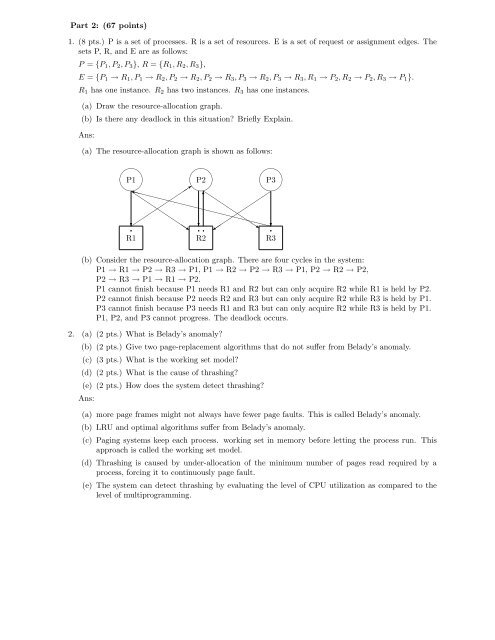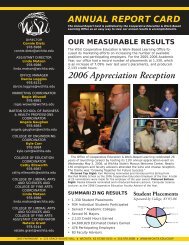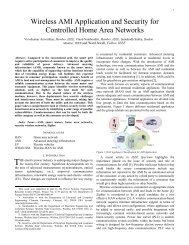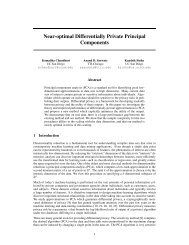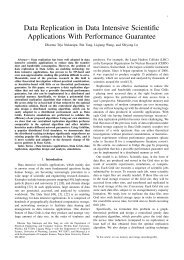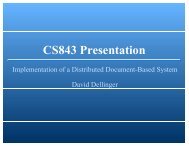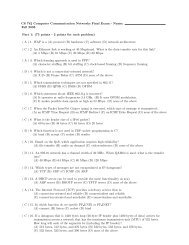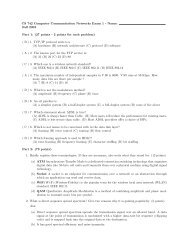CS 540 - Operating Systems - Test 2 - Name: Date: Friday ...
CS 540 - Operating Systems - Test 2 - Name: Date: Friday ...
CS 540 - Operating Systems - Test 2 - Name: Date: Friday ...
Create successful ePaper yourself
Turn your PDF publications into a flip-book with our unique Google optimized e-Paper software.
Part 2: (67 points)<br />
1. (8 pts.) P is a set of processes. R is a set of resources. E is a set of request or assignment edges. The<br />
sets P, R, and E are as follows:<br />
P = {P 1 , P 2 , P 3 }, R = {R 1 , R 2 , R 3 },<br />
E = {P 1 → R 1 , P 1 → R 2 , P 2 → R 2 , P 2 → R 3 , P 3 → R 2 , P 3 → R 3 , R 1 → P 2 , R 2 → P 2 , R 3 → P 1 }.<br />
R 1 has one instance. R 2 has two instances. R 3 has one instances.<br />
(a) Draw the resource-allocation graph.<br />
(b) Is there any deadlock in this situation? Briefly Explain.<br />
Ans:<br />
(a) The resource-allocation graph is shown as follows:<br />
✛✘<br />
✛✘<br />
✛✘<br />
P1<br />
P2<br />
P3<br />
✚✙ ✚✙ ✚✙<br />
◗❳❳2 ❳ ◗◗◗◗◗<br />
❳ ❳❳ ✻◗ ✑<br />
❳ ◗◗◗◗◗◗ ✑<br />
❳❳<br />
❳ ✑<br />
❳❳ ✑<br />
❄✑ ✑✑✑✑✑✑✑✸ ❳ ✑ ❳<br />
◗<br />
❄ ✑<br />
❳ ❳❳<br />
✑✰<br />
❳❄<br />
R1 R2 R3<br />
(b) Consider the resource-allocation graph. There are four cycles in the system:<br />
P1 → R1 → P2 → R3 → P1, P1 → R2 → P2 → R3 → P1, P2 → R2 → P2,<br />
P2 → R3 → P1 → R1 → P2.<br />
P1 cannot finish because P1 needs R1 and R2 but can only acquire R2 while R1 is held by P2.<br />
P2 cannot finish because P2 needs R2 and R3 but can only acquire R2 while R3 is held by P1.<br />
P3 cannot finish because P3 needs R1 and R3 but can only acquire R2 while R3 is held by P1.<br />
P1, P2, and P3 cannot progress. The deadlock occurs.<br />
2. (a) (2 pts.) What is Belady’s anomaly?<br />
(b) (2 pts.) Give two page-replacement algorithms that do not suffer from Belady’s anomaly.<br />
(c) (3 pts.) What is the working set model?<br />
(d) (2 pts.) What is the cause of thrashing?<br />
(e) (2 pts.) How does the system detect thrashing?<br />
Ans:<br />
(a) more page frames might not always have fewer page faults. This is called Belady’s anomaly.<br />
(b) LRU and optimal algorithms suffer from Belady’s anomaly.<br />
(c) Paging systems keep each process. working set in memory before letting the process run. This<br />
approach is called the working set model.<br />
(d) Thrashing is caused by under-allocation of the minimum number of pages read required by a<br />
process, forcing it to continuously page fault.<br />
(e) The system can detect thrashing by evaluating the level of CPU utilization as compared to the<br />
level of multiprogramming.


